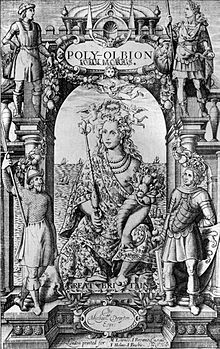William Hole (engraver)

William Hole or Holle (died 1624) was an English
engraver
.
Career
His first dated plates belong to 1607, among them the title page for a London edition of the Breeches Bible.
For many books, Hole engraved a portrait of the author, such as John Florio's 1611 Italian and English dictionary, George Chapman's 1616 translation of the Iliad, and George Wither's 1617 book of poems.[1] Hole also made maps and travelogue material.
Music engraving
For the publication
copperplate engraving was used for English music scores,[2] although engraved music had been printed on the continent from the late 16th century. This development was particularly important for keyboard music, as movable type
was not really suitable for printing keyboard music in standard musical notation.
Legacy
Some of Hole's work is in the British Museum.
References
- ^ Lee, Sidney, ed. (1891). . Dictionary of National Biography. Vol. 27. London: Smith, Elder & Co.
- ^ Latham In Latham, Alison. "Parthenia | (Gk., 'virgin dances')". The Oxford Companion to Music. Oxford University Press. Retrieved 10 June 2020.
External links
![]() Media related to William Hole (engraver) at Wikimedia Commons
Media related to William Hole (engraver) at Wikimedia Commons
